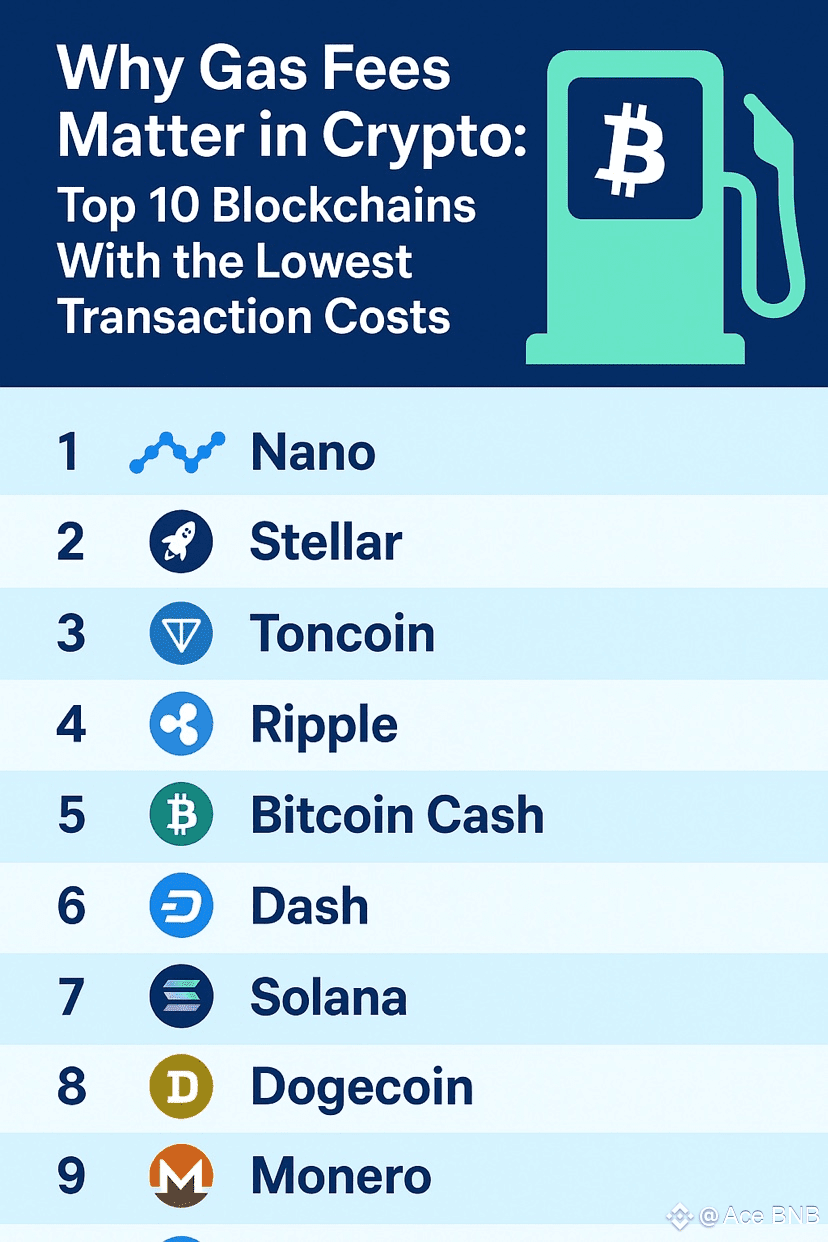
Gas fees are a core part of how blockchains operate. They compensate validators, prevent spam, and secure networks. But when fees are high, anything from simple transfers to DeFi operations can become expensive, limiting usage especially for small amounts. Because of this, blockchains with low transaction costs are increasingly desirable—for users, developers, and businesses alike.
In this article, we’ll explain what gas fees are, why they exist, how they’re calculated, and highlight the top 10 blockchains with the lowest transaction fees
What Are Gas Fees & Why Do They Exist
Gas fees are transaction charges paid by users on many blockchain networks (especially those supporting smart contracts) for operations like:
Sending crypto from one wallet to another
Executing smart contracts
DeFi operations, NFT transfers, etc.
These fees serve several key purposes:
Incentivize Validators / Miners: Nodes that validate transactions need to be compensated. The gas fee (or portion of it) is their reward.
Prevent Spam & Overuse: By attaching a cost to transactions, networks limit malicious overloading. Otherwise, someone could clog the network with many tiny or useless operarions.
Prioritize Transactions: Gas fees often fluctuate with network demand. During congestion, users willing to pay higher gas get their transactions included sooner.
How Gas Fees Are Calculated
Gas fees are generally based on two main components:
Gas Limit (or computational cost): How much “work” (computation, memory, etc.) the transaction requires.
Gas Price: What users are willing to pay per unit of that work (often adjusted by congestion and priority).
Multiply gas limit × gas price = base cost. Sometimes additional “tip” or “priority fee” is added to incentivize faster processing.
Factors That Make Fees High or Low
Blockchain Design / Consensus Mechanism: Proof of Work vs Proof of Stake vs other models matter.
Smart Contract Complexity: More complex transactions cost more to compute.
Network Congestion: More pending transactions → higher gas price needed.
Throughput & Scalability: Blockchains with high transaction throughput (TPS—transactions per second) or layer‐2 scaling tend to have lower fees.
Architecture (e.g. sharding, DAG, sidechains) that reduces bottlenecks.
Top 10 Blockchains With the Lowest Transaction and Gas Fees
Based on recent data (e.g. Cryptomus’s “Top-10 Crypto with Lowest Transaction Fees”) and other sources, here are some of the cheapest blockchains / cryptocurrencies for transactions. The list includes both networks and specific tokens. Costs are approximate, can vary over time, and depend on network conditions.
Nano ( XNO )
Stellar ( XLM )
Toncoin ( $TON )
Ripple ( $XRP )
Bitcoin Cash ( BCH )
Dash
Solana ( $SOL )
Dogecoin ( DOGE )
Monero ( XMR )
Polygon ( POL )
These will vary with token price and network demand
Why Low Gas Fees Matter for Adoption
Microtransactions & Everyday Use: If sending crypto costs almost as much as the amount you’re sending, people won’t use it for small payments. Low fees enable micropayments.
DeFi / NFTs / dApps Activity: Complex operations with multiple contract interactions magnify fees; cheaper blockchains support more frequent usage.
Onboarding New Users: Users unfamiliar with crypto are discouraged if fees are unpredictable or high. Simplicity and cost predictability improve UX.
Cross‐Border & Global Remittances: Lower costs make crypto more viable for sending money internationally.
Trade‐Offs: What You Might Sacrifice
While low transaction fees are attractive, choosing a blockchain isn’t just about cost. Here are some trade-offs to consider:
Security & Decentralization: Some high-throughput or low-fee chains may compromise on decentralization or use less battle-tested consensus mechanisms.
Ecosystem & Features: Big ecosystems like Ethereum have many dApps, tools, DeFi protocols. A cheaper chain might have fewer apps or developer support.
Speed vs Finality: Fast blockchains sometimes have weaker guarantees of finality or may be more vulnerable to certain attacks.
Liquidity & Adoption: If few people use or trade on a blockchain, it might be cheaper but harder to interact with or convert assets.
Tips for Users to Minimize Gas Fees
Choose Off-Peak Times: When network congestion is lower, gas prices often drop.
Use Layer-2 (L2) Scaling Solutions: L2s for Ethereum, etc., can drastically reduce fees for dApp interactions.
Batch Transactions: If possible, bundle many operations into one transaction.
Select Blockchains Wisely: Use cheaper networks when doing simple transfers.
Watch for Fee Caps / Wallet Settings: Some wallets allow you to set max gas price or choose transaction priority.
Conclusion
Gas fees might seem like a technical detail, but they are central to how blockchains function—and how usable they are. High fees can stifle adoption, especially for small users, microtransactions, and those in developing regions. Conversely, blockchains with very low fees offer tangible advantages: accessibility, efficiency, and broader utility.
If you value cost-efficiency, then chains like Nano, Stellar, Toncoin, Ripple, and others listed here represent compelling alternatives. As the crypto space evolves, more blockchains and solutions will likely emerge that balance low cost with strong security and good features.



